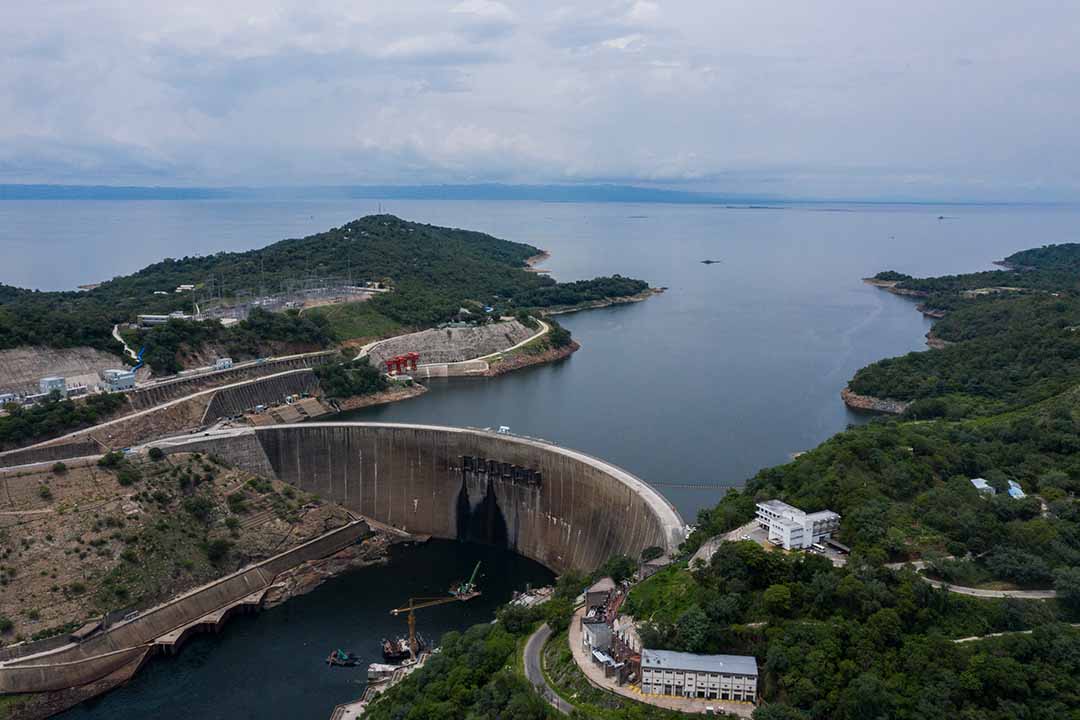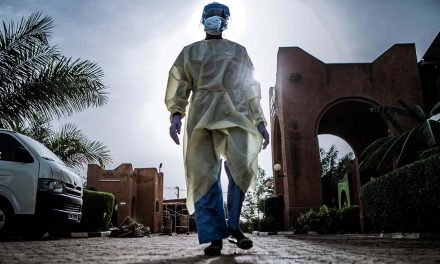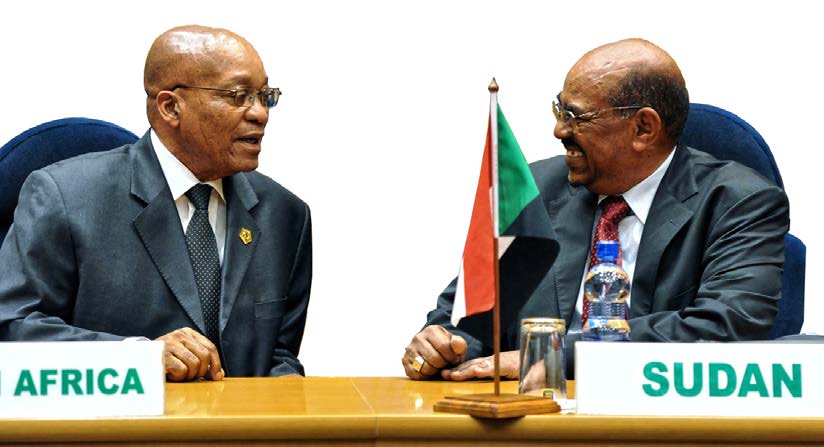Africa has vast untapped sources of hydroelectricity but climate change, particularly droughts, raises questions about sustainability.
Hydroelectricity has an attractive appeal for Africa. It can provide a baseload – a reliable source of electricity – not easily attainable from other clean energy sources, and it also allows grid stabilisation to integrate more green power. Only about 11% of the continent’s hydropower potential has been tapped but regional plans to more than double hydro production by 2030 exist. Yet, future weather changes such as droughts put power generation at risk.

The Kariba Dam and the Kariba lake in Kariba on January 20, 2020. From the Zambian side the plant is managed by ZESCO, a state-owned power company. In the absence of sufficient rain, the Kariba dam, the main source of electricity for Zambia and Zimbabwe, is expected to operate at only 25% of its capacity in 2020. (Photo by Guillem Sartorio / AFP)
Ambitions for universal access to power by 2025 mean connecting 200 million households, nearly doubling grid generation, according to a 2018 African Development Bank (AfDB) report. Despite being home to 17% of the world’s population, Africa accounts for just 4% of global power. The continent does, however, have the highest percentage of untapped technical hydropower potential in the world, says Cristina Diez Santos, International Hydropower Association (IHA) Africa analyst. With energy demand growing twice as fast as the global average, she notes, Africa has the opportunity to use its vast untapped hydropower resources to become the first continent to develop its economy using renewable energy.
Africa has a total installed capacity exceeding 37 MW, accounting for 15% of the total electricity share in the region, but that still leaves 600 million people – about half of the continent’s population – without electricity. For many African nations, hydroelectricity could address this energy gap. The AfDB, through the New Deal on Energy for Africa strategy, a partnership between the bank, governments and other stakeholders that launched in 2016, has backed power projects contributing around 2.78 GW of additional generation capacity, out of which about 755 MW, or less than 30%, is from hydropower.
“The sustainable development of Africa’s significant, yet largely untapped hydropower potential, will aid the achievement of the continent’s ambitions in terms of energy access and increased generation capacity to underpin economic development,” Daniel-Alexander Schroth, the acting director for Renewable Energy and Energy Efficiency at the AfDB told Africa in Fact. “We are [also] cognisant that the complex nature of hydropower projects requires extensive planning, continued partnership, cooperation and learning, especially in the face of climate change challenges.”
Over the past 15 years, the AfDB has invested $560 million in about 20 hydropower projects with a total capacity of over 1.8 GW, out of which about 570 MW are already installed, and the remaining 1.2 GW are yet to be commissioned. The operations supported by the bank’s funding range from small-scale hydro plants such as Sahanivotry in Madagascar (15 MW) and Buseruka in Uganda (9 MW), to large-scale hydro projects like Itezhi-Tezhi in Zambia (120 MW) and Bujagali in Uganda (250 MW). “The threat of climate change will not stop hydropower continuing to be a large part of Africa’s energy mix,” says Malama Chileshe, energy economist at the Common Market for Eastern and Southern Africa (COMESA) in Lusaka, Zambia.
The Democratic Republic of Congo (DRC) has Africa’s largest hydropower potential, estimated to be 100,000 megawatts – that is, almost half of the current installed generation capacity on the entire continent, says Chileshe. An estimated $14 billion is required to complete the Inga III hydroelectric mega-dam in the DRC, according to an October 2019 report by the NGO Resource Matters and the Congo Study Group. On completion, the Inga III will become the largest hydropower plant in sub-Saharan Africa. But the DRC, Namibia, Zambia, Ethiopia, Togo, and Sudan are the only African nations that get more than 90% of their power from hydro. “[Hydropower] is barely touched,” says Chileshe.
“It therefore makes sense that efforts should be made to develop the available resource, especially
considering the fact that currently the bulk of power production comes from thermal sources considered environmentally unfriendly.” However, in Africa, the impact of climate change on the power sector and the energy-water nexus cannot be ignored. Any African countries that are dependent on hydro power will be hard-hit in times of drought. For example, as they had in 2015, in 2019 Zambia and Zimbabwe both experienced erratic rainfall patterns, which resulted in low water levels at the Kariba dam; this led to a loss of more than 70% of electricity production from the dam’s hydro power plants.
In Kenya, a drought between 1999 and 2002 drastically affected hydropower generation, including a 25% reduction in capacity in 2000, Chileshe says. Kariba dam, a double-curvature concrete arch dam in the Kariba Gorge of the Zambezi river basin between Zambia and Zimbabwe, was designed to produce 1,200 megawatts on the basis of 50 years of records of the Zambezi river’s flow. In the past 60 years of its operations, Kariba has spilled five times – illustrating that the original calculations were sound, according to Eddie Cross, a Bulawayo-based Zimbabwean economist. Zambia and Zimbabwe have now doubled generation demand, which has proved to be beyond the dam’s capacity, with water for generation purposes almost running out in 2019, Cross says.
But this year has seen exceptional rains in the Kariba’s catchment areas. At between 55 to 60 billion cubic metres of water inflow, the river’s flow is four times that of 2019, and it is expected that the dam will reach full capacity. “What we are now doing is moving towards using the dam as storage and generating significant solar energy from the sun, and running the Kariba generators at night,” he says. “The whole system needs to be managed,” he cautions. “We have to investigate barrages and river flow technologies below large dams.” Cross argues that hydro is still the best choice for Africa – “it’s cheap and clean” – but he advocates using a mix of technologies.
Wind, hydro and solar are also possible, while coal is still critical for baseload, but should be minimised. While Africa produces just 2% of the world’s energy-related CO2 emissions, climate-related effects
are disproportionately higher in the region, which highlights the importance of a diverse power mix and regional interconnections, Santos says. “Hydropower is a clean power source, which helps to offset the impacts of fossil fuels. Hydropower infrastructure also provides essential adaptation services to reduce the impacts of climate change such as floods and drought,” she told Africa in Fact.
Chileshe says that while developing the hydro potential in places where the rain patterns are still good is important, there is a need for long-term thinking on how Africa will manage the energy- water nexus. Apart from adapting to climate change through diversifying the energy mix to include solar, wind, and geothermal, the continent has to be more interconnected, he argues. “Renewable energies such as solar and wind are associated with issues of variability, due to the constantly changing nature of weather patterns,” Chileshe told Africa in Fact.
These sources of energy need to be coupled with sources that are more reliable, such as hydro, where flowing water is available. Regional integration can also play a role by enabling nations to exchange electricity from regions of plenty to regions of scarcity, he says. For example, when its dry in one region, it may be raining in another. Endeavours to interconnect the power systems of Kenya, Tanzania and Zambia such as the Southern African Power Pool (SAPP), begun in 1995, and the Eastern Africa Power Pool (EAPP), begun in 2005, facilitate this type of trade, Chileshe adds. Pairing hydro and renewable sources of power could also help manage the effects of climate change, he suggests.
In Scandinavia, for example, Norway has plenty of hydropower plants, while a neighbouring country, Denmark, has wind. Each of these countries can switch off its own form of generation and rely on electricity from the other’s source, depending on environmental and other conditions. “The hydro potential in the African region could be managed in the same way,” Chileshe says. The AfDB also works with regional power pools to ensure that the sustainable development of hydropower resources is underpinned by strong policy, regulatory frameworks, developed regional power markets, sustainable financial and operational performance in the face of climate change challenges, says Schroth.
Santos agrees, saying that if not managed effectively, climate risks associated with dependency on precipitation can lead to shortcomings in terms of a plant’s technical and operational performance. In May 2019, IHA launched a guideline on hydropower climate resilience, which helps decision makers to make effective choices when planning, developing and operating a hydropower project. But, though “cheap and clean”, not everybody thinks hydropower is the right path for Africa. “It is not feasible,” says Siziwe Mota, Africa programme campaigner for International Rivers, which has been assisting dam-affected communities worldwide since 1985, as well as working to protect rivers and the people who depend on them.
“As large dams continue being constructed on the continent, the destruction of river ecosystems and displacement of communities, destruction of livelihoods, and an increase in countries’ debt burden is experienced,” she says. Dams, she adds, also fall short of achieving their intended purpose, especially in the face of climate change and increasingly erratic rainfall, which can reduce energy and water benefits from dams and increase the risks. In March last year, for example, power supply from the Cahora Bassa dam was cut when Cyclone Idai hit Mozambique, highlighting yet another climate-induced disaster that makes big dams vulnerable.
“Dams and reservoirs are significant sources of carbon dioxide and methane, which are greenhouse gases and should by no means be considered ‘green’,” she told Africa in Fact. International Rivers has worked to ensure that dam developers do not gain access to climate finance, such as the Green Climate Fund, for dam projects. Unfortunately, Mota says, African countries are using funds that could be invested in clean, sustainable, renewable, decentralised, alternative sources of energy to either construct, rehabilitate or expand dam projects, leaving little room for investment in clean technologies such as wind, solar or micro-hydropower.
“Hydropower’s time has passed, even though Africa has developed only about 11% of its potential,” says David Zarembka, the former coordinator of the African Great Lakes Initiative, who lives in Lumakanda, a small town in western Kenya. “Those [projects] that are only in the discussing, planning, and financing stages should be dropped. I think that some of the dams now under construction will never be completed.” Zarembka argues that dams take too long to build, usually a decade or more for a large dam. They can also be hazardous if they breach, as happened recently with a dam in Kenya. “Solar, wind, geothermal, and storage are becoming much cheaper than hydro and can usually be built in a year or two rather than a decade or more,” he says.
The amount of hydropower under construction or in the planning stages in sub-Saharan Africa far exceeds its needs for the next decade or two, he argues. Some of those under construction, such as the Grand Renaissance dam in Ethiopia, will become white elephants, he told Africa in Fact. Facing the future should involve energy policy planning that is inclusive of communities and addresses their water and energy needs, while addressing broader social, economic and environmental concerns, observes Mota. “The key challenge for Africa is not merely to increase energy consumption, but to also ensure equitable access to cleaner energy sources, guided by good energy planning,” she adds.
Munyaradzi Makoni is a journalist based in Cape Town, South Africa. He writes mostly on agriculture, climate change, environment, health, higher education, sustainable development and science in general. Some of his work has appeared in Hakai magazine, Intellectual Property Watch, IPS, Mongabay, Nature, Nature Index, Physics World, Science, SciDev.net, The Lancet, Thomson Reuters Foundation, and University World News, among others.












